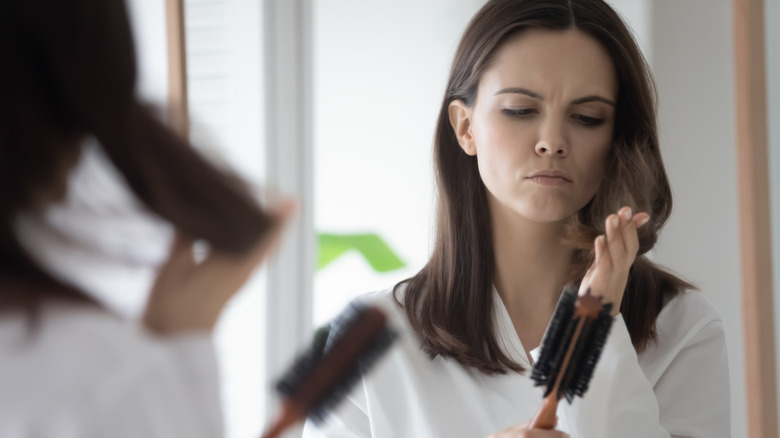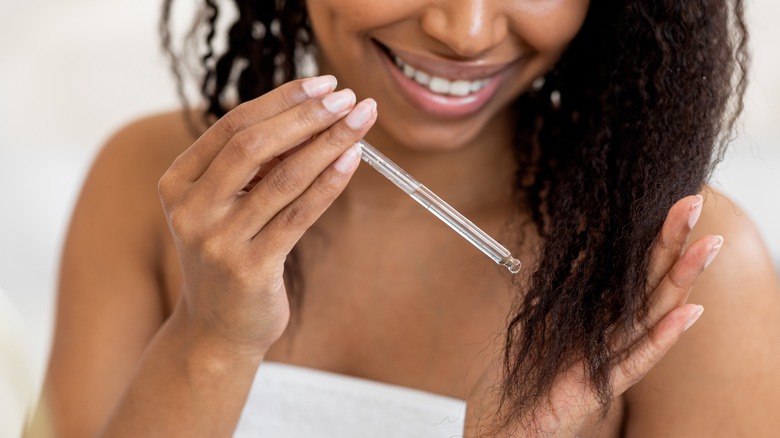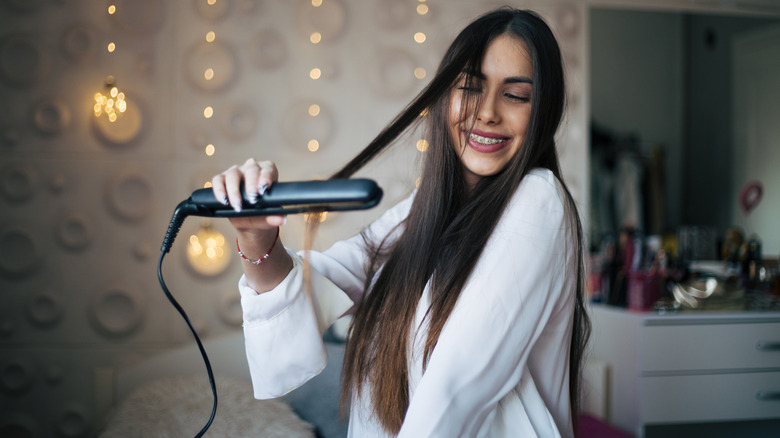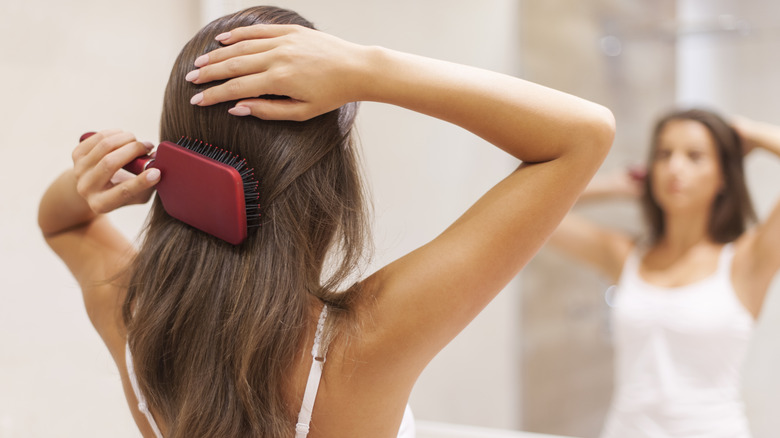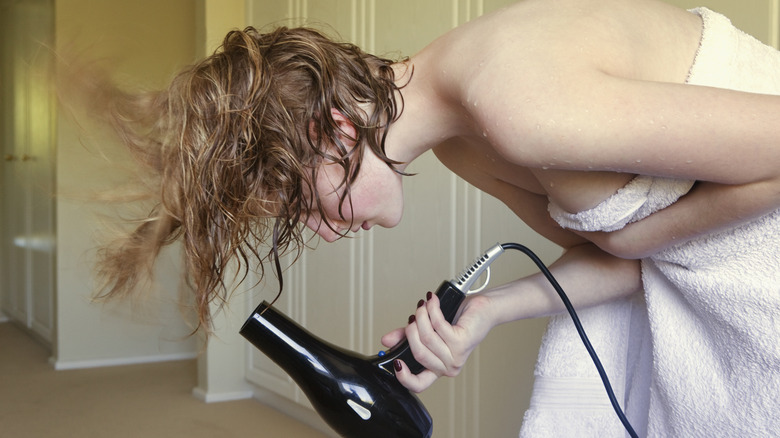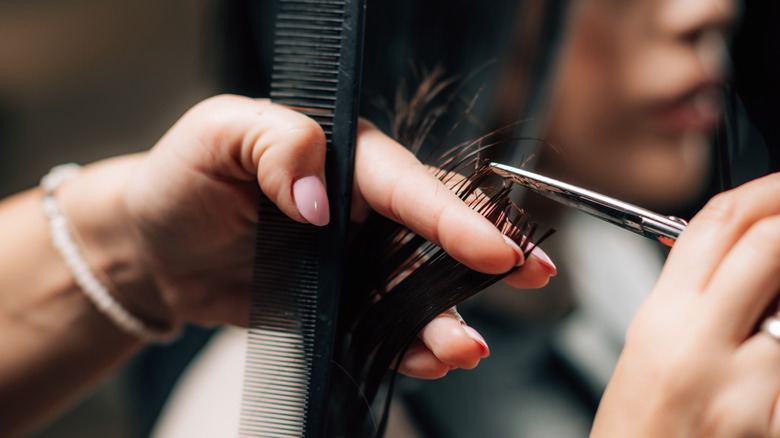12 Ways To Stop Frustrating Hair Breakage For Good
No matter the length of your hair, you likely know that sometimes dealing with it is no picnic. Aside from the washing, conditioning, styling, daily brushing, and possible tangles you encounter throughout the day, your hair may also suffer from being brittle, making it more susceptible to breakage. Hair breakage makes hair harder to deal with on the daily and can lead to a fairly unsightly look, which is probably the last thing you'd like to worry about.
Want to know if you're dealing with hair breakage? There are a few ways to tell. You may be able to tell just by looking at your hair — if you see a lot of white spots (particularly toward your ends), that's a good sign of breakage. If you brush your hair regularly and notice strands breaking off the shaft mid-brush, that's another hallmark of hair breakage. Split and frayed ends are also telltale signs. Dry, frizzy hair is more prone to breakage as well.
Hair breakage can be annoying, but we have some good news for you: You're not resigned to the fate of never-ending breaking hair. With a little prep and a lot of patience, you can stop frustrating hair breakage for good.
What causes hair breakage?
Many things can cause hair breakage and damage, but as Goldwell National Artist Steven Picciano tells PureWow, "Hair breakage is generally caused by two main factors: chemical or mechanical (aka physical) damage."
If you frequently bleach, perm, relax, or dye your hair, you may notice dryness and brittleness due to the chemicals used in the process. "When any of these processes are done, the hair's disulfide bonds are broken down, which is detrimental because these bonds count for one-third of the hair's strength," adds Gretchen Friese, a certified trichologist for BosleyMD.
Using hot tools often, over-washing, and a vitamin-deficient diet can also contribute. Even if you take good care of your hair, giving it plenty of moisture, leaving out the chemicals, and skipping the hot tools, you may still notice hair breakage depending on your daily hair habits. Rough brushing that tears through knots is a frequent culprit, as are many tight updos and hair-pulling elastic hair ties.
How to tell if you have hair breakage
If there's one good thing we have to say about hair breakage, it's that it tends to be obvious whether you're dealing with it. "You can differentiate damaged hair from healthy hair as hair that is damaged tends to be shorter with frayed ends," dermatologist Corey L. Hartman explains to Allure. "Healthy hair is well moisturized with an intact, shiny cuticular layer. It is shiny and smooth with good elasticity."
Split ends are one of the most common signs of hair breakage. When you brush your hair, do you frequently see small strands falling out? While seeing a few strands is normal, if you aggressively brush and see short snapped-off bits, it's likely a sign of damage. Even if you're not seeing these mini strands come out during your hair routine, there are several other telltale signs of hair breakage.
You can get a good gauge of whether you're dealing with breakage by feeling for signs, like tangles or rough straw-like textures. If your hair is frequently tangled beyond what you'd expect from your daily activities (or if it easily tangles post-shower) or feels brittle down the length of the shaft, that's another good sign you may be dealing with some breakage.
Make sure your hair stays moisturized
As you already know, many causes of hair breakage have to do with hair dryness. It follows, then, that one of the best (and easiest) ways to combat hair breakage is by tackling your dryness problem first and foremost. Making sure your hair has plenty of moisture is one of the keys to conquering your breakage problem.
For starters, when you shower, keep your shampoo close to the scalp and refrain from rubbing it along the length of your hair. Shampoo is meant to cleanse your scalp of excess oil and other buildup and generally isn't needed down the length of your hair, especially if your hair is pretty dry. Invest in a good moisturizing conditioner and add a deep conditioner into your routine.
Use the deep conditioner every few washes at first; if your hair starts getting greasy, you can cut it back or use it more often if you're still dealing with dryness. A moisturizing leave-in conditioner will help, as will rinsing your hair in cold water (which helps close the hair shaft). Don't forget to apply hair oil to your damp hair post-shower! Curly girls, skip the towel drying and practice plopping your curly hair to help lock in all that moisture post-shower.
Lay off the hot tools
You may hate us for this one, but we'd be remiss not to mention it: All that heat you've been using to style your hair is probably (definitely) contributing to hair breakage. This means your flat irons, curling wands, and everything else you may be using to heat treat your hair is likely doing more harm than good. If you regularly use hot tools to style your hair and you're noticing a lot of breakage, it's probably a good idea to lay off the tools for a while.
Don't worry; we're not telling you to give up your heat tools forever. Just use them sparingly, and when you do use heat to style your hair, make sure you're doing it in the least damaging way possible. Apply a heat protectant spray to your hair before using your tool, and use it on a lower heat setting if you can. Avoid going over one section of hair multiple times. If you use heat tools relatively regularly, it's a good idea to restore some moisture to your hair weekly by applying a hair mask.
Choose your brushes carefully
Unfortunately, the type of brush you use could be causing hair breakage. And not just that, but how you brush your hair can also contribute to breakage — make sure you're brushing from bottom to top and not top to bottom, as the latter will tear through knots and cause further breakage.
Wondering if it's time to toss your old hairbrush and get a new one? If you have curly hair and are dealing with significant breakage, opt for a wide-toothed comb instead. Use it only in the shower to help comb out knots as you condition. If you have thick, straight, or wavy hair prone to dryness, switching to a boar bristle brush will help significantly.
Boar bristles will help distribute your hair's natural oils from root to end. You never want to tear through knots, though; if your hair is particularly hard to brush, use a detangling spray or cream before brushing. Fine or thinning hair, on the other hand, might want to stay away from regular use of any bristles that pull on the hair, like a boar bristle brush. Instead, opt for one with wide-spaced bristles with rubber tips, which will be gentler on your hair.
Avoid frequent blow drying with high heat
Listen, we get it: You're busy, and you have to get out the door and go about your day right after you take your morning shower. Nobody wants to leave the house with a wet head, though, so it's only natural to reach for the blow dryer as soon as you step out of the shower. It's a problem that plagues us all, but even worse (in our opinion) is the problem of hair breakage, which your blow dry routine could be contributing to significantly.
As a tool that blows heat directly onto your hair, it's unsurprising that your blow dryer is probably causing some of your hair breakage. The natural conclusion, then, is that air drying is probably the way to go — but alas, that's not the case either. Air drying can contribute to an overproduction of scalp oils, meaning your hair may feel greasier between washes, and you'll feel the need to shampoo sooner in a vicious cycle.
It seems like a lose-lose situation, but we're glad to report that there's a happy medium available. Don't ditch your blow dryer altogether; instead, use it sparingly and on a low to moderate heat setting. Focus your blow dryer on your scalp and the roots of your hair, and let the lengths of your hair air-dry to avoid contributing to breakage.
Choose the right shampoo
Maybe you don't use heat tools, don't blow dry your hair, and use a great conditioner, but you're still dealing with breakage. If this is the case, your shampoo could very well be the culprit. Even if you're only scrubbing it into your scalp, certain ingredients in shampoo can dry out your strands and should be replaced with a shampoo with ingredients that nourish your strands instead.
Take a look at your shampoo bottle and see if it contains sulfates or parabens. These ingredients can contribute to hair drying and should be avoided. Fortunately, it's not hard nowadays to find a sulfate and paraben-free shampoo.
Haircare brand Shea Moisture is a great choice that's free of sulfates, parabens, silicone, and phthalates. As far as ingredients to look for in a shampoo, keratin and peptides are great for strengthening your hair, and you'll want to check the ingredients label for natural moisturizing ingredients (like shea butter, plant oils, and squalane).
Take care when wearing your hair up
We know the last thing you want to hear at this point is that you have to abandon your precious updo. At the end of the day, you do you, girlie — just know that your everyday ponytail or messy bun likely isn't doing any favors for your hair's health and could actually be contributing to hair breakage. Don't toss out all your hair elastics in protest, though. Instead, take into account whether you're making any of the following ponytail mistakes that could be causing hair breakage.
Ponytail mistake number one is the endless tugging and pulling that you do when you make a ponytail, tighten it throughout the day, and take it out later. Gentleness is key when it comes to the ponytail game. Tie your hair back loosely (stay away from tight, slicked-back styles), refrain from pulling it tightly throughout the day, and remove your hair elastic slowly and carefully, without yanking it out. Don't wear it up too often if you can avoid it, and don't wear it up at night so you can give your scalp a bit of a break.
Make sure you're getting trims
We should all be getting our hair trimmed regularly, and if you're dealing with significant breakage, trimming can be especially important to keep your hair healthy and mitigate future breakage. Aside from just getting rid of split ends, getting your hair trimmed regularly can actually help prevent further breakage from happening. How often to trim will depend on how healthy your hair is, as well as its length, type, and texture. We recommend checking in with your hairstylist to get their recommendation on how often you should be coming in.
If you're brushing your hair and constantly tugging on split ends, you're putting more pressure on the shaft of your hair, which can cause it to break off prematurely. "When split ends are left untouched, a small split can travel up the hair shaft and cause even more damage to your strands," celebrity natural hair growth expert Whitney Eaddy tells The Zoe Report. "Even if you're growing your hair out, a trim every three months is suggested," stylist Shelly Aguirre adds. "Split ends keep splitting, so getting a dusting on the ends will actually make your hair grow faster."
Incorporate hair oil into your routine
An oft-overlooked yet stunningly effective way to nourish dry hair is by incorporating hair oil into your routine. Personally, we think hair oil is a bit slept on, and if you're dealing with breakage, it's time to change that. Not all hair oils are created equal, though; you'll want to look for one with nourishing ingredients that are also free from chemicals.
We love the Moroccanoil brand of hair oils, as Moroccan oil helps to moisturize your hair without making it greasy. In fact, it's a great oil to use if greasy hair is a concern, as it mitigates your scalp's sebum production, which can contribute to that oily feeling.
In general, you'll want to look for the same types of ingredients that you're now looking for in your shampoo: moisturizing ingredients like plant oils that will help hydrate your hair's shaft. Apply the oil to damp hair after showering and before styling to help combat daily frizz and lock in moisture, and apply more between washes as needed.
Sleep on silk pillowcases
Unfortunately, you could be contributing to your own hair breakage even while catching up on beauty rest. However, it's definitely preventable. If you frequently wake up with dry, tangled hair, we have some news for you: Your pillowcase could be the culprit.
When you think about it, it's not surprising that pillowcases could be a factor causing your hair breakage. As you toss and turn during the night, the friction of your hair against the pillowcase can pull on the shaft, causing both frizz and possible hair breakage. It follows, then, that solving the problem would require reducing the friction of your hair against the pillowcase.
This is where silk pillowcases come in particularly handy. Its surface isn't as rough as that of your typical cotton pillowcase, so your hair will glide along it more gently even as you toss and turn. As a bonus, silk pillowcases will help your hair retain moisture, too, since they'll absorb less of your hair's natural oil than a cotton pillowcase would.
Try some vitamins or supplements
Sometimes you do everything right, and it still seems to make no difference in your hair breakage. You wash with the most moisturizing shampoo and conditioner on the market, you promptly got rid of all your heat tools, you wear your hair down 24/7 and sleep on the finest of silk pillowcases, and it seems that it's all been for naught. If this is the case, it could be that your hair is missing key vitamins that are necessary for healthy growth.
Sure, you can add some nutrients to your hair via conditioner or hair oil, but sometimes they have to actually get in your system to do any good. Before starting a new vitamin regime, it's always a good idea to talk to your doctor and check for deficiencies first. Some vitamins and supplements to consider, according to the Cleveland Clinic, are vitamins A, B, and C, as well as biotin, zinc, iron, and omega-3. You can likely find some of these in a standard multivitamin, while others will have to be taken on their own.
Talk to your doctor about possible medical causes
In some cases, hair breakage can be caused by an underlying medical condition that will need to be diagnosed by a medical doctor in order to be treated. If you've exhausted all other options, or if your hair breakage has come on fairly recently and is accompanied by other symptoms, it's a good idea to talk to your doctor and make sure nothing else is going on.
Again, an underlying cause could be as simple as being deficient in one of the vitamins or minerals listed above, in which case a simple supplement regimen may do the trick. However, there are some other underlying causes that couple be the culprit of your hair breakage. Medical News Today notes that hypothyroidism could be the reason for your hair breakage, other signs of which include brittle fingernails and itchy skin. Stress and eating disorders also can be contributing factors.
Make sure you protect your hair from the elements
At the start of summer, all you want to do is let your hair down (both literally and figuratively) and soak in the summer sun. We don't mean to rain on your parade, but letting your hair come into contact with all of the fun things summer has to offer, like the sun and chlorine, isn't doing you any favors — and is more than likely contributing to hair breakage. When it comes to enjoying all the fun warm weather has to offer, we'd venture to bet you'll have a better time knowing your hair isn't going to suffer along the way.
Before you get upset, don't worry: Protecting your hair in the summer doesn't have to mean sacrificing your style. If you really want to let your hair fly free, invest in some SPF for your hair and scalp to help protect it from the sun. A floppy sun hat is a fun way to protect your hair and amp up your summer style, too. If your days are going to be spent at the pool, though, keep your hair from coming in contact with the chlorine as much as possible, and rinse with clean water if you just can't help but dunk your head in the pool (we don't blame you!).

